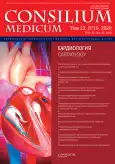Insulin resistance: focus on the pathogenesis of cardiomyopathy
- Authors: Shishkova V.N.1,2, Martynov A.I.1
-
Affiliations:
- Yevdokimov Moscow State University of Medicine and Dentistry
- Center for Speech Pathology and Neurorehabilitation
- Issue: Vol 22, No 10 (2020)
- Pages: 52-54
- Section: Articles
- URL: https://journals.rcsi.science/2075-1753/article/view/95316
- DOI: https://doi.org/10.26442/20751753.2020.10.200341
- ID: 95316
Cite item
Full Text
Abstract
Full Text
##article.viewOnOriginalSite##About the authors
Veronika N. Shishkova
Yevdokimov Moscow State University of Medicine and Dentistry; Center for Speech Pathology and Neurorehabilitation
Email: veronika-1306@mail.ru
канд. мед. наук, ст. науч. сотр., врач-эндокринолог Moscow, Russia
Anatolii I. Martynov
Yevdokimov Moscow State University of Medicine and DentistryMoscow, Russia
References
- Feigin VL, Roth M, Naghavi GA et al. Global burden of stroke and risk factors in 188 countries, during 1990-2013: a systematic analysis for the global burden of disease study 2013. Lancet Neurol 2016; 15 (9): 913-24.
- Чазова И.Е., Мычка В.Б. Метаболический синдром. М.: Media Medica, 2004.
- Bozkurt B, Aguilar D, Deswal A, Dunbar SB et al. Contributory risk and management of comorbidi-tiesof hypertension, obesity, diabetes mellitus, hyperlipidemia, and metabolic syndrome in chronic heart failure: A scientific statement from the American Heart Association. Circulation 2016; 134 (23): e535-e578.
- Devereux RB, Roman MJ, Paranicas M. Impact of diabetes on cardiac structure and function: the strong heart study. Circulation 2000; 101: 2271-6.
- Rubler S. Dlugash J, Yuceoglu YZ et al. New type of cardiomyopathy associated with diabetic glomerulosclerosis. Am J Cardiol 1972; 30 (6): 595-602.
- Yancy CW, Jessup M, Bozkurt B et al. 2013 ACCF/AHA guideline for the management of heart failure: a report of the American College of CardiologyFoundation/American Heart Association Task Force on Practice Guidelines. J Am Coll Cardiol 2013; 62: e147-e239.
- Nakamura M, Sadoshima J. Mechanisms of physiological and pathological cardiac hypertrophy. Nat Rev Cardiol 2018; 15: 387-407.
- Lopaschuk GD, Ussher JR, Folmes CD et al. Myocardial fatty acid metabolism in health and disease. Physiol Rev 2010; 90: 207-58.
- Rijzewijk LJ, van der Meer RW, Diamant M et al. Myoca rdial steatosis is an independent predictor of diastolic dysfunction in type 2 diabetes mellitus. J Am Coll Cardiol 2008; 52: 1793-9.
- Rijzewijk LJ, van der Meer RW, Lamb HJ et al. Altered myocardial substrate metabolism and decreased diastolic function in nonischemic human diabetic cardiomyopathy: studies with cardiac positron emission tomography and magnetic resonance imaging. J Am Coll Cardiol 2009; 54: 1524-32.
- Haemmerle G, Moustafa T, Woelkart G et al. ATGL-mediated fat catabolism regulates cardiac mitochondrial function via PPAR-a and PGC-1. Nat Med 2011; 17: 1076-85.
- Bikman BT, Summers SA. Ceramides as modulators of cellular and whole-body metabolism. J Clin Invest 2011; 121: 4222-30.
- Jornayvaz FR, Shulman GI. Diacylglycerol activation of protein kinase Ce and hepatic insulin resistance. Cell Metab 2012; 15: 574-84.
- McCoin CS, Knotss TA, Adams SH. Acylcarnitines - old actors auditioning for new roles in metabolic physiology. Nat Rev Endocrinol 2015; 11: 617-25.
- Schooneman MG, Vaz FM, Houten SM, Soeters MR. Acylcarnitines: reflecting or inflicting insulin resistance. Diabetes 2013; 62: 1-8.
- Makrecka M, Kuka J, Volska K et al. Long-chain acylcarnitine content determines the pattern of energymetabolism in cardiac mitochondria. Mol Cell Biochem 2014; 395: 1-10.
- Ahmad T, Kelly JP, McGarrah RW et al. Prognostic implications of long-chain acylcarnitines in heart failure and reversibility with mechanical circulatory support. J Am Coll Cardiol 2016; 67: 291-9.
- Bray GA, Frunbeck G, Ryan DH et al. Management of obesity. Lancet 2016; 387: 1947-56.
- Udell JA, Cavender MA, Bhatt DL et al. Glucose-lowering drugs or strategies and cardiovascular outcomes in patients with or at risk for type 2 diabetes: a metaanalysis of randomised controlled trials. Lancet Diabet Endocrin 2015; 3: 356-66.
Supplementary files






